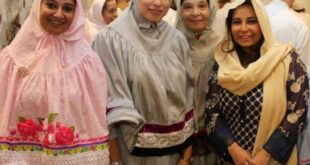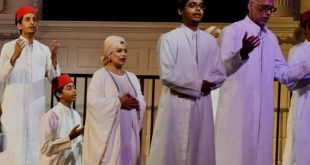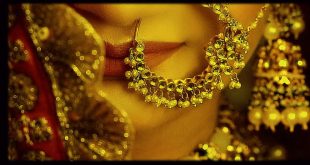
The Moor women of old were a highly cultured lot and had evolved a number of traditional customs and passed down the ages from mother to daughter over several generations. Some of these had a religious basis based as they were on the Islamic faith, while others were meant to ensure cleanliness and charm their menfolk. Here are some of them:
A SPECIAL BRIDAL GIFT
The Moor brides of old sent to their husbands-to-be a very special gift This was the preparation of a special oil cake known as kaivicci paniyaram which was sent by the bride to the bridegroom as a present the day before the wedding. An early notice, Botanical and Useful Information about trees and plants in. The Ceylon Forester of February 1895 edited by.H.P.C.Armitage refers to this cake which was prepared with the juice of the marutu (Terminalia glabra) leaf as follows: “Moorish women pound the leaves, strain off the juice, mix it with rice flour and ghee, put it in a chatty, and cook it over a slow fire adding sugar. The flat cakes thus made are called “kioechi paniaram” and are sent by the bride to the bridegroom the day before the wedding. This is the only occasion on which they are made”.
ROLE OF MIDWIFE
In traditional Moor society, childbirth very often took place at the parental home of the expectant woman where she was attended by a midwife. It was the traditional midwife known as maruttavicchi (Lit.medicine-woman) who delivered the child.
A.T. Shamsedeen in his article ‘Ceremonies relating to childbirth observed by the Moors of Ceylon’ published in The Orientalist of 1888 notes that it was customary among the Moors to have the first accouchement in the house of the woman’s parents and that it was the midwife who delivered the child. “When the time of delivery approaches”, he says “all the female relatives and connections of the family are invited; the woman is then brought to bed by the assistance of a midwife who is paid a sum of money varying from 5 to 20 rupees, besides being supplied with clothes and other presents”.
He notes that the moment a woman is delivered “she is made to swallow a nauseous drug, with the view of facilitating the expulsion of the placenta”. He adds that as soon as this is accomplished a preparation of certain drugs to act as a preventive against cold, and other puerperal diseases is administered to her. A cloth is then tied over her head, a tight bandage round her waist. She is then laid on a bed, with curtains. Underneath are placed an iron weapon, and a broom which remain there for forty days.
In the Eastern districts it was formerly the custom for the birth to take place in the female section of the house which was sometimes known as ala-veedu. This room is said to have been provided with a provision for a rope or coir cord to be attached to the roof for the delivering woman to hold on to during parturition, a practice believed to facilitate childbirth.
HERBAL BATH AFTER BIRTH
The Moor mother underwent a herbal bath. Shamsedeen in 1888 tells us that on the third day after the birth, the woman was bathed with a decoction of aromatic herbs and that this was repeated on the 7th, 15th and other days.
It is still the custom in conservative families for the woman to be rubbed from the waist downwards with a veḍu or filtrating cloth containing a mess of herbs all boiled together and including murunga maratol (bark of the Moringa Oleifera), desikka ela (lime leaves), paccha manjal (raw turmeric), pavatta (Pavetta indica), adatoda (Adhatoda Vasica) and nocchi ela (Vitex Nigundo or V.Trifolia) after which she is bathed. This usually takes place on the 7th, 9th, 15th or 40th day after the birth of the child. The practice known as ottai or vedu otti kulikkira is usually performed by the mother of the woman.
In conservative rural areas such as Mannar, it is still the practice for the newly delivered woman to remain in the house for forty days, after which she comes out and bathes in water in which margosa leaves (veppilai) have been boiled.
CIRCUMCISION OF GIRLS
It has been the practice to circumcise girls on the seventh or fortieth day after birth. It is usually the womenfolk who attend to the operation by hiring the services of an Ostamāmī or female barber for the purpose. The Ostamamiī so employed is given a small fee, usually Rs.500-1000 and sometimes a metre or so of white cloth as payment. There have however been instances where the operation is performed by qualified doctors, especially in the urban areas. However, unlike the circumcision of boys, which is often celebrated with much ceremony, the circumcision of girls is generally kept not publicized beyond the immediate family circle.
As such there seems to have been no ceremony as such. It is possible however some ceremony, however small accompanied it in the olden days, perhaps a fest confined to the womenfolk. S.E.N.Nicholas in his book Fascinating Ceylon (1950) had this to say of the Moors of his day: “We are told that the circumcision ceremony takes place on the fortieth day for female children; but in the case of the male, the ceremony is postponed till they are strong and in good health and are more able to realise the significance of the rite”.
The practice has a religious basis as there are several ahadith or sayings of the Prophet Muhammad about it. However it is in no way comparable to the practice of Female Genital Mutilation that happens in Africa. The local practice usually involves a slight incision on the skin of the clitoris to draw a little blood, a cheap substitute for the proper Islamic form of removing the prepuce covering the clitoris, a procedure analogous to male circumcision also practiced by Muslims.
NAMING TRADITIONS
Girls are usually named on the seventh or fortieth day after birth when they are circumcised. The names of Moor females like those of Moor males are largely of Arab origin. Popular names for girls include Fatima (the name of the Prophet’s beloved daughter), Ayisha, Hafsa, Khadija and Zaynab (the names of the Prophet’s wives or Ummul Moominin ‘Mothers of the Believers’ as they are usually known by the faithful) Asma (The first Caliph Abu Bakr’s daughter and the Prophet’s sister-in-law), Salma (The Prophet’s aunt, wife of his uncle Hamza), Maryam (Mary, the mother of Jesus), Hanna (Anne, the mother of Mary) and Hajara (Hagar, the wife of Abraham and mother of Ishmael). We also not uncommonly come across names like Balqis (The Queen of Sheba), Zulaykha (The wife of the Egyptian courtier who attempted to seduce Joseph), Sumayya (a lady companion of the Prophet and the first martyr in Islam) and Zubayda (The consort of Caliph Harun Al Rashid).
The name of the Prophet’s youngest daughter Fatima (Literally ‘The Weaner’) is immensely popular among the Moors as it is among other Muslim peoples and very commonly precedes the proper names of girls. However until fairly recent times it was Sitti that was commonly prefixed to the names of girls. Indeed, one still comes across plenty of Moor women, both young and old, bearing this name. That the term may have even figured in Arab personal names is suggested by the name of a woman named Sitt-al-Husn ‘Lady of Beauty’ occurring in the Alf Layla Wa Layla Thousand and One Nights). Another common practice in the olden days was to precede names with Nūr ‘light’ such as Noor Jezima, Noor Huzaima and Noor Zanooba.
NOSE ORNAMENTS
Nose-studs are today rarely worn by Moor women, though once universal among them. However they are still worn by some Moor women of Colombo, especially in areas such as Dematagoda, Maligawatta and Slave Island. They are also said to have been commonly worn by the Moor women of the Eastern areas such as Amparai District though no longer, having declined in the 1950s and 1960s. In fact in the song Palam Pakka Povom (Let’s Go See the Bridge) popular from the 1920s, we find the husband advising his wife to put on a shining nose stud (mookutti) which shows how common it would have been in the olden days in this part of the country. A few Moor women of Jaffna are also known to have worn the mookkutti.
A.T.Shamsidin in his article Ornaments worn by the Moorish women of Ceylon contributed to The Orientalist of 1886 gives among the jewellery worn by the Moor women of his day, the mūkkutti (A nose ornament made of gold, its end furnished with pendants of pearls and set with precious stones, invariably worn on the right ala of the nose) and nattu (A flat nasal trinket appended to the septum of the nose by means of a gold screw passed through an orifice formed for the purpose. The ornament falls flat upon the upper lip, having its broad end furnished with pendants of pearls and its surface set with precious stones).
Nose ornaments have an Arabian origin. This is widely attested in literature both old and new. The Alf Laya Wa Laya (The Thousand and One Nights) makes mention of the khizam which probably refers to the nose-ring since even in modern Arabic khizam means ‘nose-ring’. It figures in the story of Ma’ruf who presents his wife some ornaments including a nose-ring which she puts on. The Ladies Monthly Museum 1827 in its ‘Description of the City of Bagdad, its inhabitants, customs & C’ referring to the women of the country around Baghdad tells us that “the nose is either adorned by a large ring, or a solid, flat, circular piece of gold stuck in one nostril, of the size, shape and appearance of the fancy gilt buttons worn by the English peasantry on their Sunday coats”.Edward Lane in his Modern Egyptians (1836) gives the nose-ring (khizam) in his description of the female ornaments of Egypt and says that it was worn by both town and village women. And Richard Burton in his Narrative of a Pilgrimage to Al-Madinah and Meccah (1893) refers to the Bedouin women of Arabia wearing nose-rings. Such nose ornaments are said to be still worn in the rural areas of Arabia, Iraq and Syria according to the monumental work Arab and Islamic Silver by Saad Al- Jadir (1981), and in the desserts and oases of Egypt as recorded in the book Enchanted Jewelry of Egypt by Azza Fahmy (2007).
MULTIPLE EAR ORNAMENTS
The Moors women of old wore multiple ear ornaments known collectively as alkuttu, We have the interesting observation made by William Goonetilleke who in his paper The Disfiguring of the human body contributed to the Orientalist. Vol.IV (1890) observes that Ceylon Moor females practice the custom of boring 12 holes in the helix of the left and 13 in that of the right ear and inserting ornaments in them. However by his time “the more civilized” had given up the practice and had restricted the number of holes in the helix to two. Indeed, we were informed that in Kalpitiya in the early 1950s little Moor girls wore several gold rings along the helix of their ears. We also found that the Moor women of the Amparai District formerly wore several little silver studs or rings along the rim of their ears known collectively as allukuttu. It would appear that the alkuttu was confined to the Muslim women here and was unknown among Non-Muslim women, whether in Sri Lanka or India.. M.Winslow in his Comprehensive Tamil and English Dictionary (1862) gives alukkuttu as ‘an ear-jewel worn by Mohammedans’ while Edgar Thurston in his Ethnographic Notes in Southern India (1906) says that “Muhammadan women have their ears pierced all round the outer edges, and as many as twenty or twenty-five rings, of iron or gold, are inserted in the holes”.
Extracted from Serendib Culture Club FB Page (Courtesy: Asiff Hussein)
Post Disclaimer | Support Us
Support Us
The sailanmuslim.com web site entirely supported by individual donors and well wishers. If you regularly visit this site and wish to show your appreciation, or if you wish to see further development of sailanmuslim.com, please donate us
IMPORTANT : All content hosted on sailanmuslim.com is solely for non-commercial purposes and with the permission of original copyright holders. Any other use of the hosted content, such as for financial gain, requires express approval from the copyright owners.
 Sri lanka Muslims Web Portal Sri Lanka Muslims News Center
Sri lanka Muslims Web Portal Sri Lanka Muslims News Center
 Donate
Donate


